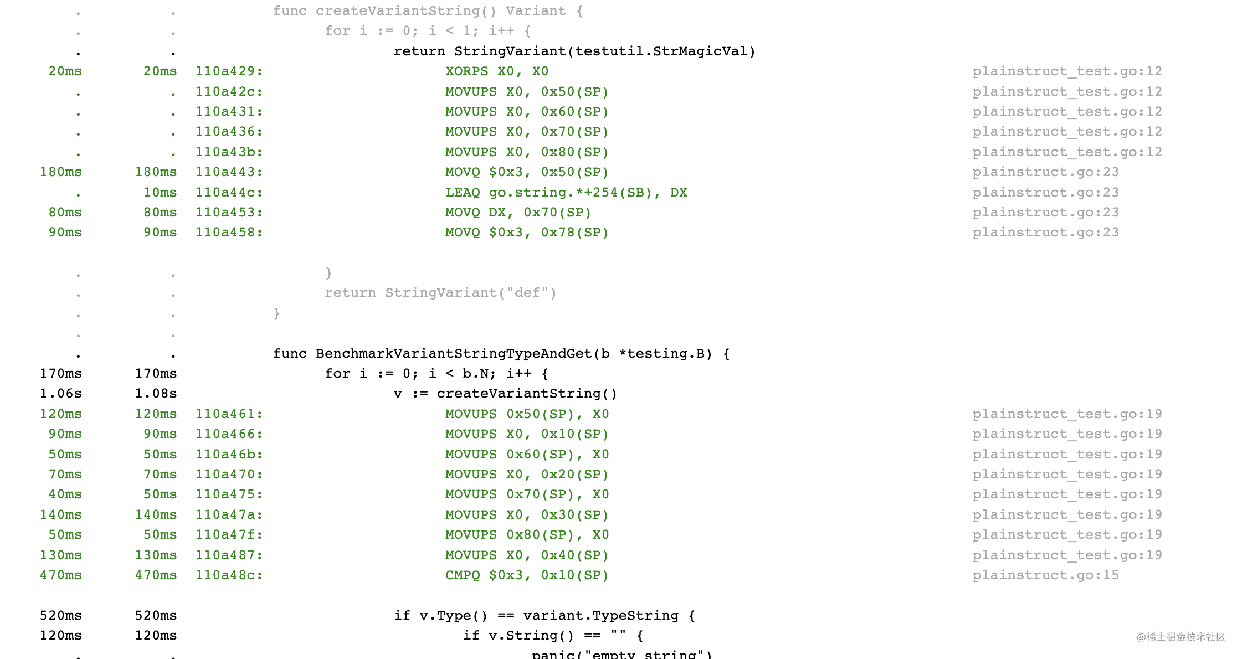go variant底层原理深入解析
用户杨杰 人气:0varint
今天本来在研究 OpenTelemetry 的基准性能测试 github.com/zdyj3170101…,测试不同网络协议:grpc, grpc-stream, http, websocket 在发送不同大小数据包时消耗 cpu,吞吐 的区别,由 tigrannajaryan 这位大神所写。
好奇翻了翻该大神的 github 仓库,发现了一个同样神奇的库。
这个库也是基准的性能测试,用来测试 go 中不同方法实现的 多类型变量 在消耗 cpu 以及 内存上的区别。
旨在实现一个能存储多类型变量并且具有最小 cpu 消耗以及 内存消耗的数据结构。
benchmarks
- Interface: 接口
- struct:struct,多个 field 存放不同类型的结构体
- variant:该库的时间

struct
struct 是一个结构体,typ 表示当前结构体的类型,不同的 field 分别存储不同的类型。
type Variant struct {
typ variant.Type
bytes []byte
str string
i int
f float64
}
struct 还有两种不同的类型。
根据是否返回指针分别为 plainstruct 和 ptrstruct。
而 ptrstruct 相比 plainstruct 就多出一次内存分配,以及增加 cpu 耗时(栈上内存分配几个移位指令就能完成)。
func StringVariant(v string) Variant {
return Variant{typ: variant.TypeString, str: v}
}
func StringVariant(v string) *Variant {
return &Variant{typ: variant.TypeString, str: v}
}
进行 benchmark 后发现 plainstruct 已经 0 byte 分配了,我也想不出还有其他的优化思路。
yangjie05-mac:plainstruct jie.yang05$ go test -bench=. -benchmem plainstruct_test.go plainstruct.go Variant size=64 bytes goos: darwin goarch: amd64 cpu: VirtualApple @ 2.50GHz BenchmarkVariantIntGet-10 1000000000 0.3111 ns/op 0 B/op 0 allocs/op BenchmarkVariantFloat64Get-10 1000000000 0.3117 ns/op 0 B/op 0 allocs/op BenchmarkVariantIntTypeAndGet-10 1000000000 0.3189 ns/op 0 B/op 0 allocs/op BenchmarkVariantStringTypeAndGet-10 141588165 8.435 ns/op 0 B/op 0 allocs/op BenchmarkVariantBytesTypeAndGet-10 140932470 8.465 ns/op 0 B/op 0 allocs/op BenchmarkVariantIntSliceGetAll-10 7293846 165.7 ns/op 640 B/op 1 allocs/op BenchmarkVariantIntSliceTypeAndGetAll-10 7491408 170.6 ns/op 640 B/op 1 allocs/op BenchmarkVariantStringSliceTypeAndGetAll-10 7061575 170.1 ns/op 640 B/op 1 allocs/op
variant
一个 variant 由指向真实数据的指针 ptr,一个紧凑的 lenandtype 同时表示长度和类型,这个数据结构还根据不同位的系统做了优化,以及 capOrVal(在slice类型数据时,就是 cap,非slice类型数据时就是val )。
- 32位系统下,type 占3位,len 用29位表示
- 64 位系统下,type占3位,len用63位表示。
Variant 设计主要是为了同时满足存储 float64 和 string 的需求。 因为 float64 的存在,必须要有一个 int64 类型的字段存储 float64 的值。 而 string 的 len 是int类型的字段,就不需要用int64。
type Variant struct {
// Pointer to the slice start for slice-based types.
ptr unsafe.Pointer
// Len and Type fields.
// Type uses `typeFieldBitCount` least significant bits, Len uses the rest.
// Len is used only for the slice-based types.
lenAndType int
// Capacity for slice-based types, or the value for other types. For Float64Val type
// contains the 64 bits of the floating point value.
capOrVal int64
}
比如创建一个string的时候,ptr 中存放指向数据的指针,而lenAndType 中存储slice的长度以及 type。 ``
// NewString creates a Variant of TypeString type.
func NewString(v string) Variant {
hdr := (*reflect.StringHeader)(unsafe.Pointer(&v))
if hdr.Len > maxSliceLen {
panic("maximum len exceeded")
}
return Variant{
ptr: unsafe.Pointer(hdr.Data),
lenAndType: (hdr.Len << typeFieldBitCount) | int(TypeString),
}
}
为什么 variant 要比 plainstruct 快
分别测试 variant 和 plainstruct 创建 string 的性能:
func createVariantString() Variant { // 防止编译优化掉?
for i := 0; i < 1; i++ {
return StringVariant(testutil.StrMagicVal)
}
return StringVariant("def")
}
func BenchmarkVariantStringTypeAndGet(b *testing.B) {
for i := 0; i < b.N; i++ {
v := createVariantString()
if v.Type() == variant.TypeString {
if v.String() == "" {
panic("empty string")
}
} else {
panic("invalid type")
}
}
}
使用 go tool 做性能测试,并查看plainstruct的profile文件:
go test -o=bin -bench=. -v -test.cpuprofile=cpuprofile plainstruct_test.go plainstruct.go go tool pprof -http=: bin cpuprofile
同理 variant:
go test -o=bin -bench=. -v -test.cpuprofile=cpuprofile variant_test.go variant.go variant_64.go go tool pprof -http=: bin cpuprofile
variant 的汇编:

plainstruct的汇编:

主要区别还是plainstrutc的指令数太多,因为struct的字段更多。
variant 可能的优化?
variant 其实这里还有一个优化的方向,就是在 32 位机器存储 float64 的时候。 将 float64 拆成两个 int32,分别用 ptr 和 capOrVal 来存储。 这样在 32位系统下,capOrVal 可以由 int64 变成 int,节省了 4 个字节。
type Variant struct {
// Pointer to the slice start for slice-based types.
ptr unsafe.Pointer
// Len and Type fields.
// Type uses `typeFieldBitCount` least significant bits, Len uses the rest.
// Len is used only for the slice-based types.
lenAndType int
capOrVal int
}加载全部内容